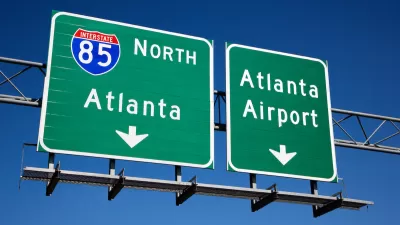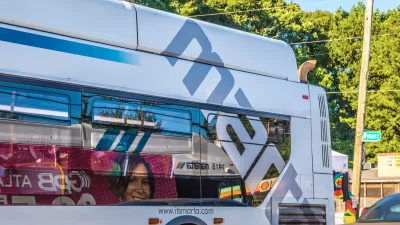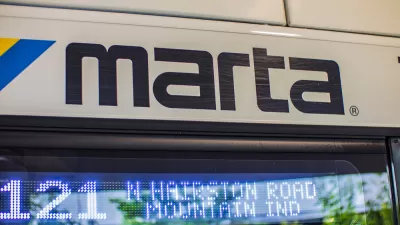Officials in the city of Atlanta are planning a groundbreaking ceremony this week for the Metropolitan Atlanta Rapid Transit Authority’s first bus rapid transit line.

Officials from Metropolitan Atlanta Rapid Transit Authority (MARTA) and the city of Atlanta will gather later this week for a ceremony to commemorate the groundbreaking on a new bus rapid transit (BRT) route—the first in the city.
“The five-mile BRT route—MARTA’s first new transit line since the Sandy Springs MARTA station opened in the year 2000—will link downtown to neighborhoods such as Summerhill and Peoplestown before ending near the BeltLine’s Southside Trail. Along the way will be connections to MARTA’s heavy rail system at Five Points, Georgia State, and Garnett Stations,” according to an article by Josh Green for Urbanize Atlanta.
“The region’s first BRT line, according to MARTA officials, will operate with new electric buses. About 85 percent of the corridor will have dedicated bus-only lanes with transit-signal priority, meaning buses shouldn’t be bogged down in traffic and that travel times should be quicker,” adds Green.
As noted in the article, the project has been delayed from an originally scheduled 2022 groundbreaking date. According to Green, “the project was dogged by skyrocketing building and labor costs, in addition to MARTA’s inexperience with creating new transit lines over the past two decades.”
Previous Planetizen coverage of Atlanta’s BRT plans:
- Atlanta Proposed Rail Line to Become Bus Rapid Transit (February 2023)
- MARTA Reveals Renderings for Bus Rapid Transit Stops (March 2023)
- Atlanta Gaining Two New ‘Arterial Rapid Transit’ Lines (April 2023)
- What Is ‘Arterial Rapid Transit?’ (June 2023)
More project details, including renderings of planned stations and a system map, can be found at the link below.
FULL STORY: Atlanta's first bus-rapid transit line finally set to break ground

Study: Maui’s Plan to Convert Vacation Rentals to Long-Term Housing Could Cause Nearly $1 Billion Economic Loss
The plan would reduce visitor accommodation by 25,% resulting in 1,900 jobs lost.

North Texas Transit Leaders Tout Benefits of TOD for Growing Region
At a summit focused on transit-oriented development, policymakers discussed how North Texas’ expanded light rail system can serve as a tool for economic growth.

Why Should We Subsidize Public Transportation?
Many public transit agencies face financial stress due to rising costs, declining fare revenue, and declining subsidies. Transit advocates must provide a strong business case for increasing public transit funding.

How to Make US Trains Faster
Changes to boarding platforms and a switch to electric trains could improve U.S. passenger rail service without the added cost of high-speed rail.

Columbia’s Revitalized ‘Loop’ Is a Hub for Local Entrepreneurs
A focus on small businesses is helping a commercial corridor in Columbia, Missouri thrive.

Invasive Insect Threatens Minnesota’s Ash Forests
The Emerald Ash Borer is a rapidly spreading invasive pest threatening Minnesota’s ash trees, and homeowners are encouraged to plant diverse replacement species, avoid moving ash firewood, and monitor for signs of infestation.
Urban Design for Planners 1: Software Tools
This six-course series explores essential urban design concepts using open source software and equips planners with the tools they need to participate fully in the urban design process.
Planning for Universal Design
Learn the tools for implementing Universal Design in planning regulations.
Ascent Environmental
Borough of Carlisle
Institute for Housing and Urban Development Studies (IHS)
City of Grandview
Harvard GSD Executive Education
Toledo-Lucas County Plan Commissions
Salt Lake City
NYU Wagner Graduate School of Public Service





























